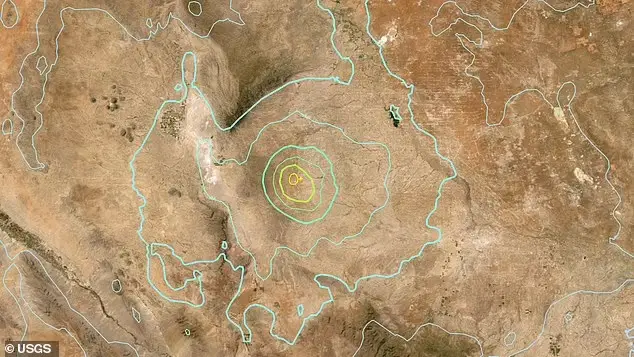On Saturday, a series of powerful earthquakes struck the remote region of West Texas, sending tremors that were felt more than 100 miles away. The largest earthquake in the series had a magnitude of 5.4 and occurred at 7:47 p.m. local time, rattling streets, buildings, and nerves throughout the area.
Powerful Tremor Strikes Near Whites City, New Mexico
The earthquake’s epicenter was located about 35 miles south of Whites City, New Mexico, which lies near the Texas state border. Initially rated at 5.3 magnitude, the tremor was later upgraded to a 5.4 magnitude event by the US Geological Society (USGS). The earthquake was recorded at a depth of 4.6 miles, making it a moderately shallow quake with significant regional impact.
As the tremors spread, video footage taken approximately 200 miles away in El Paso showed streets visibly shaking during the quake. This powerful seismic event was followed by two smaller aftershocks, both registering 2.9 in magnitude. Despite these secondary tremors, the USGS has cautioned that additional aftershocks may follow, with continued seismic activity expected throughout the coming week.

No Fatalities or Damage Reported—But Thousands Felt the Tremors
Although no fatalities or significant damage have been reported as of now, over 1,500 people have reported feeling the earthquake’s impact. Local authorities are still on alert, as the region remains vulnerable to further seismic activity. In the wake of the tremor, the USGS issued a reminder on their website for people to “Drop, Cover, and Hold on” during earthquakes, as aftershocks may continue to affect the area in the coming days.
History of Seismic Activity in West Texas
This recent quake in Culberson County is one of the strongest to hit the state in recent years. While the region is known for its occasional seismic activity, this latest event has garnered attention due to its magnitude and the widespread tremors it caused.
Texas, especially its western regions, has historically experienced earthquakes, with 17 quakes exceeding a magnitude of 5.0 since 1882, according to USGS data. The largest recorded earthquake in the state was a magnitude 8.0, which occurred in western Texas. Over the past few decades, the number of earthquakes in Texas has notably increased. Experts attribute the rise in seismic activity to the state’s extensive oil and gas extraction practices, particularly hydraulic fracturing (fracking) operations.

The Link Between Oil and Gas Extraction and Seismic Activity
Fracking involves injecting large quantities of water, chemicals, and sand into rock formations to release trapped oil and gas. While fracking itself is not generally the direct cause of earthquakes, the process of disposing wastewater produced by fracking into deep wells has been linked to increased seismic activity in Texas. This wastewater injection, known as “deep injection,” has been identified as a contributing factor to higher-magnitude earthquakes.
A 2022 study by the University of Texas at Austin revealed that 68 percent of quakes in Texas with magnitudes above 1.5 were “highly associated” with oil and gas production activities. According to Dr. Alexandros Savvaidis, a researcher at the University of Texas, “Deep injection wells, in particular, are linked to higher-magnitude earthquakes,” highlighting the potential danger posed by these practices.
While shallower injection wells are considered to pose less risk in terms of large seismic events, the growing number of deep injection wells in Texas has raised concerns about the long-term impact of oil and gas extraction on the state’s seismic stability. Dr. Savvaidis explained that as more drilling occurs, there is an increasing likelihood of larger earthquakes, especially in areas that have been subjected to high volumes of wastewater disposal.
Continued Monitoring and Future Concerns
Given the rising number of earthquakes linked to fracking, Texas officials and researchers are closely monitoring seismic activity in the region. The ongoing concern about the potential connection between oil and gas extraction and increased earthquake frequency has sparked discussions about the need for greater regulation and oversight in the industry. As seismic events continue to shake the region, residents and officials alike are left to consider the long-term implications of Texas’ booming oil and gas industry on both the environment and public safety.
As of now, authorities remain on alert, and experts continue to study the patterns of seismic activity in West Texas. While the region has always been prone to occasional tremors, the increased frequency of earthquakes has raised concerns about the future of the state’s geological stability. For residents and workers in the area, it’s clear that the consequences of Texas’ oil and gas boom may extend beyond just economic growth, with the very ground beneath their feet now shifting in unpredictable ways.
A 2022 study by the University of Texas at Austin concluded that 68 percent of Texas quakes above magnitude 1.5 were ‘highly associated’ with oil and gas production.

